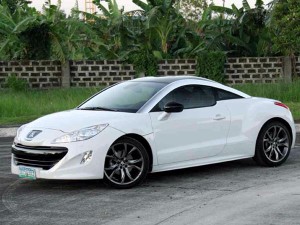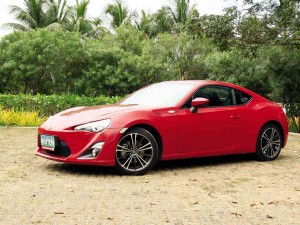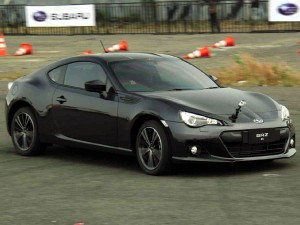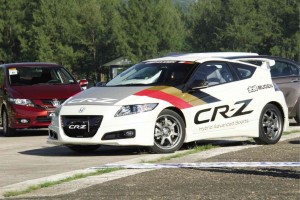Weapons of mass distraction
We’re lucky to be alive in this day and age of Philippine motoring. We have an overabundance of choices when it comes to cars, and we finally have reached a level of sophistication wherein we can see an affordable performance sports car as a very viable means of everyday transportation. We won’t get dirty looks from neighbors (perhaps only envious ones at best), nor should we feel the wrath of the BIR scrutinizing and assessing our very souls.
Driving pleasure of the highest order shouldn’t be for the preserve only of the rich and famous, it should be for everyone. We take a look at a number of affordable sports cars (affordable in that they don’t cost more than people’s houses) available directly from the dealership. If you’re looking at a spare second or third car in your household, consider any one of these and liven up your daily motoring life.
Mazda MX-5
Mazda’s MX-5 (more affectionately known as the Miata) traces its roots to the Lotus Elan and other affordable, basic and highly enjoyable European roadsters in the golden years of motoring, which was during the 1960s. Launched in 1989 at the Detroit Motorshow, the Jin Ba Ittai principle (in Japanese translating to Rider [Jin] Horse [Ba] One [Ittai]) has been preserved at a sacred level to assure increased enjoyment. The Miata remains to be the world’s best-selling sportscar and roadster (approaching a million units built and sold as of 2013) and even in today’s third-generation NC-series chassis, which has grown bigger, heavier and more complicated than the original NA-series Miata, still delivers the driving goods splendidly, with the added option of a convertible or open-air experience, something its competitors don’t possess.
There’s a healthy aftermarket support for the MX-5, so-called because it means Mazda Experiment No. 5, plus a very active social-club scene with the Miata Club Philippines. While horsepower remains modest at 166 HP and 190 Newton-meters of torque, much like the newer Toyota 86 and Subaru BR-Z, the MX-5 boasts of balance and progression, of a sense of connected feel and responsiveness that is practically hard-wired to your senses. The six-speed manual transmission has one of the best snickety-snick feelings in gear change mechanism in the business, and progression from neutral to oversteer is easily controlled. Today’s MX-5 is very much like the original 1990s Miata, but now boasting of modern technologies and convenience (ABS brakes, dual airbags, traction/stability control), and the insulation and refinement afforded by a metal folding roof with a proper glass rear windscreen. Often overlooked, but still highly capable.
Toyota 86
There’s much to love about the 86: sharp, modern looks; responsive handling; well-packaged engineering; a very low center of gravity; sharp steering; brakes and throttle; a very rigid chassis. You essentially run out of superlatives when describing the 86. That’s just how great a car it is, and it captures the bare-bones, fun-to-drive essence of a sports car. That truly is the romance in driving. The 86 is also one of those keeper cars: You can keep it for a lifetime and grow your skills with the 86, and the 86 is more than capable of rewarding the newbie driver as it does a highly experienced driver. It talks to you warmly, doesn’t feel aloof, and you feel like a hero just driving it at 7/10 on a winding mountain road.
A number of people complain about the lack of power, and as we’ll see later, a good number of tuners have modified the 86 (and the BR-Z) to almost double their power outputs, but the vast majority of people are happy with it, nonetheless. The 86 is a car that also keeps you honest: Despite the modest power, you can still find yourself in trouble if you’re not careful with your inputs and are not smooth with the steering, throttle and clutch. Yet despite its sportiness, it’s still comfortable enough to use every day. Admittedly, the back seats are pretty much useless, but use them (along with the diminutive trunk) as cargo space and you’ll be amazed at how much you can fit inside the 86. The steering and brakes, though firm and progressive, are light enough to use even by members of the fairer sex.
Subaru BR-Z
As above, but with the added cache of owning a Subaru, who bill themselves to be the premium Japanese alternative. The Subaru BR-Z feels slightly more premium, more up-market, (many of the optional extras in the 86 have been made standard in the BR-Z) and a slightly lower, slightly firmer ride height that’s been developed more for track use than the open road/drifting as the 86. Both share the same excellent Aisin six-speed transmission and the same FA20 (Subaru engine code)/4U-GSE (Toyota engine code) flat-four, 2-liter, dohc 16-valve engine that features D4-S dual direct and indirect gasoline injection, delivering 197 HP and 205 Nm of torque, but requires 100-octane fuel for this. Despite the modest (by modern standards) power, throw in an all-in weight of under 1,300 kilograms, matched with near 50:50 weight distribution, packed with the latest in integrated vehicle dynamics control (adjustable traction-stability control, ABS-EBD brakes) with fantastic headroom for tuning, and you’ve got yourself a future classic. As with the 86, you practically run out of superlatives when describing one. Drive it hard especially on the track and you’ll also run out of expletives, such is its sheer joy of driving performance.
As mentioned above, it’s comfortable enough to pull double duty as a daily driver and weekend toy car, but the engine delivers impressive consumption, thanks to the dual direct injection and light overall weight. In the city, with typical traffic, getting 8 kilometers per liter is easy with the manual and, out on the highway, 12 kpl is achievable with the a/c on, traveling under semilegal (if there’s such a term) speeds.
On the track, especially tight, twisty and technical layouts, the BR-Z delights as it eagerly clips all the apexes, rides FIA regulation kerbing confidently and late-brakes like Vettel overtaking the field on an F1 grid. Yank the handbrake for those 180- and 360-degree turns and it’ll acquit itself well on gymkhana/slalom tracks, too. If you want real exotic car feel and feedback, the firm, reassuring and progressive feel and weight of steering, brake and throttle inputs, matched with truly sharp, incisive steering that borders on telepathic, it’s hard to beat the BR-Z (and the 86 of course!)
Hyundai Genesis
Coming from the very sporty Toyota 86/Subaru BR-Z duo, we find ourselves in Hyundai’s supercompetent Genesis coupe. The 86 and BR-Z are more focused performance cars, the Genesis trades some of the sharpness for a slightly more genteel, more relaxed—but offers far better long-distance—cruising comfort. It is, after all, a sporting GT rather than an out-and-out sports car. Fancy a drive up north? The Genesis delivers the goods, has a more relaxed high-speed pace, and the interior feels very close to a luxury coupe (in a good way) rather than the pared-back interior of the BR-Z and 86. Leg-, knee- and footroom are impressive; you can wear clogs and have enough space to fit your feet inside and the back seats, though still cramped, are far more useable in the Genesis than the 86. You’ve also got two engine options, a 3.8 V6 and a 2.0 direct injection turbo four-cylinder. Choice engine, in my opinion is the V6 with the very impressive and highly responsive eight-speed automatic transmission, which features manual control.
This is the ideal combination as it really improves the effortless character of the Genesis. Even the supportive seats are some of the best in the business: Covered in leather, it holds you in place, but it’s softly padded so your backside is kept cool and comfortable even after very long (and I mean 5 hours or longer) stints inside the Genesis. The V6 makes a very pleasing 299 HP and 361 Nm of torque, while the inline four-turbo makes 256 HP and 353 Nm of torque. Should you get the six-speed manual, Brembo front four-piston brakes are available as an option, and it’s a wise choice to get these as well because you can never have enough brakes and you’ll love the added stopping power and fade-free performance from sustained high-speed runs. Relaxed high-speed cruising ability, impressive refinement, oodles of space in a stylish body, the Genesis offers a lot of power, punch and pizzazz in a very attractive price.
Peugeot RC-Z

The Peugeot RC-Z is not much of a sports car and not a long-distance tourer, but is still loads of fun.
The Peugeot is the only real oddity in this group. It’s not much of a sports car and not exactly a long-distance tourer (its diminutive size and short wheelbase mean it won’t have the high-speed refinement and stability of the Genesis). But it’s still loads of fun, and in this company will net you the most curious/admiring/quizzical looks because it is the rarest car of the group. Definitively French, which means quirky (the bubble roof is inspired by Design House Zagato’s double bubble roof). It’s also the easiest to use every day because getting in and out is not a gymnastics workout (especially for guys my size), and the bubble roof increases headroom. The 1.6 turbo engine isn’t particularly powerful but offers more than enough grunt, delivering a modest but very useful 156 HP and 240 Nm of torque over a broad powerband that peaks early. You can get it with either a six-speed manual or six-speed automatic, but since the RC-Z is more style than performance (not that it feels limp on the road), the preferred transmission is the automatic especially as it’s also FWD. Fear not as the French know a thing or two about making FWD cars handle. European journalists have good reviews of the RC-Z, and my stint behind it was equally delightful. It was a willing partner, but it somehow preferred to travel at its own pace, much like how the French prefer to do things their way.
It doesn’t actually feel fast but it’s always eager to play (it weaves and bobs a bit on the highway because of the big wheels, low-profile tires and quick steering). A cursory look at the speedometer, in intervals of 30 kilometers per hour, will get you over legal speeds briskly should you give the RC-Z a longer leash. It rides really firm, too, due to the massive 19-inch wheels on a short wheelbase vehicle, but looks jaw-droppingly exotic. The Elan/Sportif kit allows you to mix and match exterior colors with the color of the double bubble roof, door mirrors and front grille.
Honda CR-Z
The last practical performance car looks frumpy compared to the lot. Honda’s CR-Z however boasts of a pedigree that almost matches Toyota’s AE86. Its predecessor, the CR-X, was a very popular weekend warrior vehicle, particularly to Japanese and American racers. It is specifically the second-generation CR-X, which received full wishbone suspension all-around, and Honda’s legendary B16A twin-cam VTEC engine, which to this day remains very popular. In 2010, 13 years after the third-generation CR-X ended, Honda released the CR-Z, and the spec sheet remains the same: a fuel-efficient yet very sporty fastback coupe. Rather than relying on turbocharging, direct injection or both, Honda’s engineers decided to fit in an integrated motor assist (IMA) to add more zing low-down. The result is surprisingly electric (pun intended). The IMA hybrid system gives its boost low-down in the revolutions per minute range to deliver spritely acceleration from standstill. The 1.5-liter engine produces 112 HP and 145 Nm of torque with the six-speed manual, or 111 HP and 144 Nm of torque with the CVT transmission. The electric motor helps add a further 14 HP and 79 Nm of torque from as low as 1,000 rpm, but drive it sanely and you can net fuel consumptions as good as 12 kilometers per liter in the city with ease, and almost 20kpl on the highway. It seems odd why fuel consumption will be an issue in a sports car, and Honda engineers have placed such a high premium on fuel efficiency. Regardless of hybrid technology and fuel efficiency, the CR-Z remains to be a proper sports coupe. It feels sharp, has well-judged damping so it floats sweetly over the rough stuff, excellent body control for those memorable twisting mountain drives, and the slick-shifting six-speed manual means you’ll love rowing through the gears, heel-toe downshifting and double de-clutching just for the sheer pleasure of it. It’s also very easy to use, and the rear seats tumble down to increase cargo space. Definitely a worthy successor to the CR-X.

















